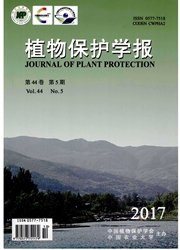

 中文摘要:
中文摘要:
利用Biolog—Eco方法对以抗虫转cry1Ab基因粳稻(KMD1/KMD2)及其对照(秀水11)为食的褐飞虱肠道微生物群落多样性进行比较研究,以评价其对该飞虱肠道微生物多样性的影响。室内试验结果表明,褐飞虱以KMD1或KMD2为食持续1、3、5代后,其肠道微生物多样性指数(包括Shannon、Simpson和McIntosh指数)与对照无明显差异,但以KMD1为食时,其微生物群落的平均颜色变化率(AWCD)明显高于KMD2和对照。田间调查结果与室内试验基本相似。综合分析认为,KMD1和KMD2对其非靶标害虫褐飞虱肠道微生物群落多样性无明显的负面影响。
 英文摘要:
英文摘要:
The diversity, of intestinal microbial community in the brown planthopper, Nilaparvata lugens fed on transgenic cry1Ab rice (KMD1 and KMD2) or non-transgenic control (Xiushui 11 ) was compared using Biolog-Eco method to define the impacts of transgenic crylAb rice on the diversity of intestinal microbial community in the planthopper. Laboratory results showed that the diversity indexes including Shannon index, Simpson index and McIntosh index of the intestinal microbial community in the brown planthoppers fed on KMD1 and KMD2 for either of one, three or five generations were not significantly different from those fed on the control. In contrast, the average well color development (AWCD) of the intestinal microbial community in the brown planthoppers fed on KMD1 was markedly higher than that fed on either KMD2 or the control. As to the field test, the result was almost the same as that of the laboratory tests. In conclusion, it is suggested that impacts of both KMD1 and KMD2 on the diversity of the intestinal microbial community of non-target insect pest, Nilaparvata lugens were not significantly negative.
 同期刊论文项目
同期刊论文项目
 同项目期刊论文
同项目期刊论文
 Impacts of Six Bt Rice Lines on Non-target Rice Feeding Thrips, Stenchaetothrips biformis (Thysanopt
Impacts of Six Bt Rice Lines on Non-target Rice Feeding Thrips, Stenchaetothrips biformis (Thysanopt 期刊信息
期刊信息
